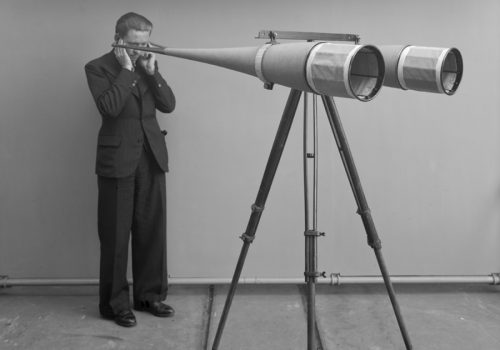The CNRS archives are full of thousands of images testifying to decades of research and inventions. This heritage, produced between 1915 and 1938, is currently the subject of a major exhibition as part of the international photography festival in Arles.
These unrecognized images are the visual witnesses of twenty years of research and inventions initially related to war and national defense, then oriented to civil and domestic life. They sketch a history of innovation, crossed by design, at the crossroads of science, technology and industry. These photographs also tell the beginnings of the institutionalization of the research, since the creation, in 1915, of a Department of inventions concerning the national defense by the minister and mathematician Paul Painlevé, until the creation of the CNRS in 1939 by Jean Perrin. In these documents, the future Nobel Prize in physics is himself inventor: mobilized as an engineer during the First World War, he develops a bugle increasing the range of the sound, or a giant stethoscope to detect underground sounds .
Everything begins in the heart of the first world conflict, at the end of 1916, when the Republican Jules-Louis Breton was appointed head of the under-secretary of state for inventions concerning national defense. Breton, who hates the bureaucracy and its slowness, systematises the use of photography precisely to accelerate processes and transform an idea, from whichever comes, into a defensive, offensive or domestic object that can be used as quickly as possible.
In this republic of inventions, nothing is hierarchical, like the vision of a Breton, attentive to large and small projects and supporting with the same ardor research in pure science and applied science. No distinction appears in the way of taking photos: the principle of shooting remains the same for more than thirty years. In still lifes and staged with extras, there are sequences and time series. It is finally a kind of photographic watch of the inventions that Breton’s service produces.
Over the course of days and experiences, clichés accumulate like so many observations populating a large virtual laboratory notebook. These thousands of images confront us with the meanders of technical progress, the sometimes touching vacillations of the very process of creation. With behind this process, ruthless stimuli: the war (survive), then the more moderate incentives of economic growth (better living).
Of the hundreds of inventions systematically photographed from 1917, few have really resulted in a mass-produced object or contributed to a major scientific discovery. Many files were closed without further action, the Inventions Department being a laboratory. It brings together people from different backgrounds who try, test … and that does not matter if it does not work, we will miss the next time, according to the expression of Samuel Beckett.
To see until September 22, 2019.
The exhibition The saga of inventions. From the gas mask to the washing machine, the CNRS archives, co-produced by the Rencontres d’Arles and the CNRS, in partnership with the National Archives, Luce Lebart police station, is to be seen in Arles at Espace Cruise:
July 1 – September 22. 10H00 – 19H30
https://www.rencontres-arles.com/fr/expositions/view/780/la-saga-des-inventions
















